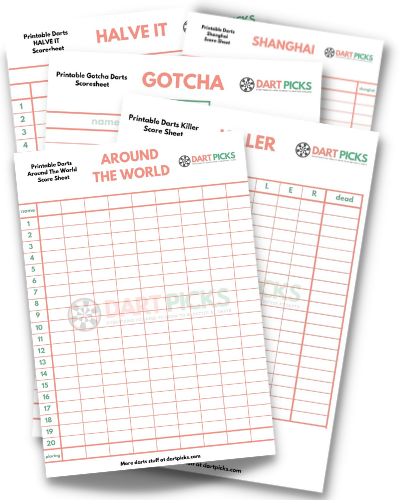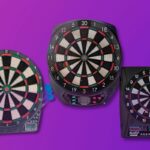People have loved playing darts for centuries and one of the beauties of the sport is how cheap and easy it is to set up a dartboard at home. Since its birth in the 1860s, it has evolved over time from its origins as a pub sport to a great activity for people of all ages and skill levels. With some basic guidelines, anyone can get a board up on the wall with minimum effort. This post will outline how to accurately set up a dartboard so you too can enjoy this great game.
Need a dartboard? Check out the best dartboards for under $100.
Table of Contents
What You Need to Set up a Dartboard
To set up a dartboard at home, you’ll need:
- A dartboard
- A wall that is at least 6 feet 8 inches high and away from windows
- A minimum of 9 feet (274cm) of the area back from the wall to throw
- A drill to make the holes in the wall
- A screw if attaching to a wall stud, or a wall-anchor (often these will be included with your dart board)
- A measuring tape
Dartboard Specifics
The standard international dartboard is called the “clock” board. The typical dartboard measurement is 18 inches in diameter and has 20 numbered pie-shaped sectors of equivalent dimension, plus the bull’s eye.
Each numbered segment has a double ring outside the border of the scoring area and an interior three-way ring (which counts as double and triple of that number).
The bull’s-eye has an outer bull area (likewise known as the solitary bull, which scores 25) and an internal bull (also called a dual bull’s-eye, which scores 50).
Height of the Board on the Wall
Firstly let’s look at the height of the board on the wall. We want to ensure that the inner bullseye is 5 feet 8 inches (or 173cm) from the floor.

Before you go measuring up and piercing a hole in your wall, check the back of your dartboard for the area of the mounting bracket. Not all dartboards have their installing brackets dead center, and this is specifically true of electronic dartboards.
Fixing the dartboard to a wall surface stud is the best place on a wall, given that it will make sure the dartboard is extremely secure. Wall studs are vital pieces of wood inside the wall. If you can’t hang the dartboard on a wall stud, make sure to use a suitable wall surface anchor that will support the board’s weight.
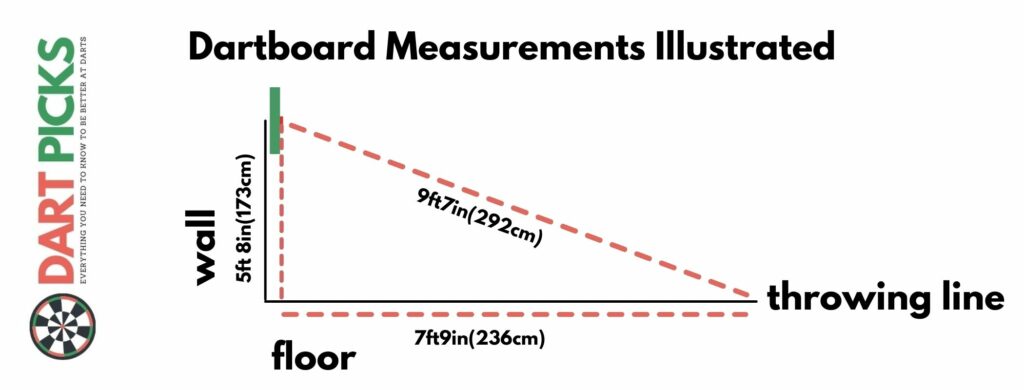
Once you’ve measured where your holes in the wall will need to ensure the bullseye of your board is 5ft 8 inches (173cm) from the floor .
Dartboard Regulations
- Dartboard height: 5 feet 8 inches (1m 73cm) from flooring to the center of the bullseye.
- Diagonal distance from the bullseye to the throwing line: 7 feet 9 1/4 inches (2.37m). To mark the throw line, measure from wall but remember to come out from the wall the depth of your board (as it is not included in your measurements).
- Mounting: Flush to the wall surface – not leaning like a photo – with the number 20 segment on top.
- Throw lane: As you stand on the throw line and look towards the board, you should have a corridor of at least 2ft (61cm) of clear space. Darts frequently bounce out of the dartboard and those sharp points can be dangerous.

Never put a dartboard up near home windows or breakables or where anybody can walk between the throw line and the board. Remember that if darts hit the floor they are sharp so if your floor needs protection a dart mat is a good idea.
The dart scoreboard should be mounted to the left or right of the dartboard for easy access.
How to Mount a Dartboard
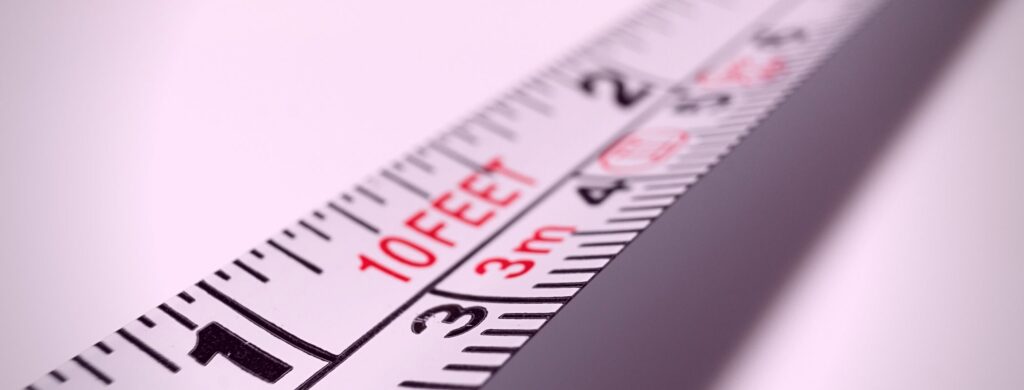
The process of mounting dartboards is pretty straightforward. When you purchase your board, it will come with a guidebook and parts list that details how to install the board in your home. Most come with fixings you’ll require.
What is the Best Thing to Put Behind a Dartboard?
Be sure to plan out a good backstop behind your dartboard. You don’t want to end up with holes everywhere. If you’re on a budget and are not intending to buy a dart backboard you can use anything from corkboard to wooden planks and even cardboard. Basically, anything that stops your wall looking like it’s got woodworm from all those practice throws. Just be generous with the area you think might need to be covered.
If you anticipate a lot of beginners using the board, aim to have at least 10-12 inches (25-30cm) clearance in every direction of the board. This should allow for enough space without getting smacked by stray darts or for a new player to accidentally hit themselves while throwing their own darts – it has happened!
Hopefully, everyone will be able to at least hit a target that size, with few exceptions!
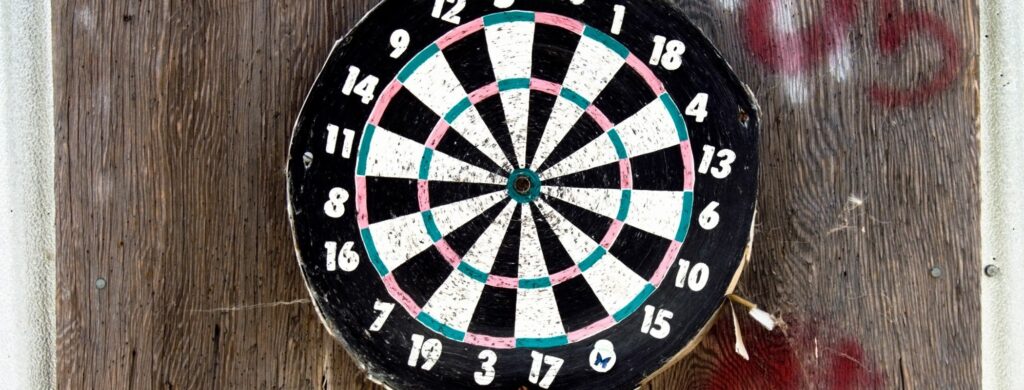
Here are some other ideas for the potential material you can maybe recycle and use as a backboard for your darts board:
- Styrofoam
- Rope
- Carpet
- Rubber
- Cardboard
- Wood offcuts
- MDF (medium density fiberboard)
- Insulation
- Carpet
How to Mount Electronic Dartboards
A much less hands-on job than bristle boards, electronic dartboards typically have pre-made holes that you can insert and place on your wall. Don’t worry too much concerning installation; the correct measurements are always included in the manual for electronic dartboards.
How to Mount Magnetic Dartboards

The easiest dartboard to mount is the magnetic dartboard. These boards come with an eyelet at the top of the board so you can hook them on anything. They’re designed like this because usually they’re double-sided and can be flipped – so no permanent fixings here. They are portable and perfect for kids’ outdoor games.
As a reminder, never set up a dartboard near home windows, glass, anything delicate should be sufficient distance away. And remember, young children will always need supervision, even with magnetic darts.
Ladies Throwing Distance
Currently, Ladies Championship darts official throwing distance is exactly the same as men at 7ft 9 ¼ inch( 2.37m). However, some women might prefer to be closer and the measurement most commonly used are 7ft 6in (228cm) or 7ft (213cm).
Final Thoughts
Setting up a dartboard for the first time may seem a bit daunting but if you can use a tape measure and a drill, it’s pretty easy and doesn’t take long.
A few other things to keep in mind:
- Always check you have enough space to install a dart board by ACTUALLY measuring – don’t just eyeball it.
- Ask someone to help you – it’s far easier measurin gup etc when you have someone to help
- Use a pencil to lightly mark on the walls when measuring up – this will help with accuracy
Hopefully, it should only take you about a half-hour to get this on the wall, and then you’ve got a lot of throwing to enjoy!
Alex Cooper is the editor of this website. He loves darts and helping people. Alex started playing darts at the young age of 10, as his father was also a keen darts player, and has loved it ever since. Alex enjoys writing about darts and helping others learn more about the sport.
The easy way to keep track of your score is with our printable darts scoresheets. Easy to download and keep on your phone or computer or print straight off from our website. Pop your email address into the box and we'll send them straight to you.

